News
Installing Solar Panels through SolarCity
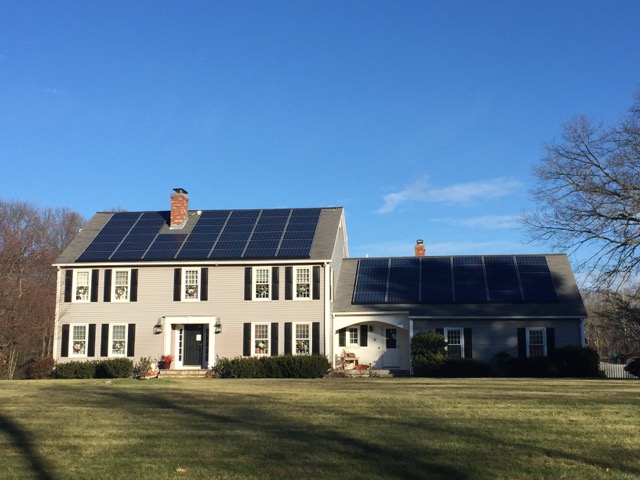
 Shortly after placing my order for my Tesla Model S I started looking into installing a solar panel system at home as a way to offset the soon-to-be increased electricity bill. My research turned me to a SolarCity system which I ended up signing up with in April of 2014.
Shortly after placing my order for my Tesla Model S I started looking into installing a solar panel system at home as a way to offset the soon-to-be increased electricity bill. My research turned me to a SolarCity system which I ended up signing up with in April of 2014.
After a number of scoping, design, and utility company challenges the day finally came for installation.
Sizing the Job
While I had originally hoped for a much larger system, the system that was installed was still large by most people’s standards. The final design called for 70 panels, each capable of generating 255W for a total of 17.8 kW and an annual expected output of 18,611 kWh.
To put that into perspective, my Model S uses an average of 775 kWh (as measured through a digital submeter) or approximately 2,400 miles. That usage will climb a bit for the winter months, but I still intend to use about 9,300 kWh per year for my Model S which equates to 50% of my expected solar generation capacity.
What this means is that I’ll be driving my Model S on 100% solar generated energy and still have solar energy to spare to offset my normal electric costs.
Many installations are half this size or smaller due to a number of constraints. Because of the size of this job, SolarCity booked 2 days for the install and sent a crew of about 8 to do the work.
Scheduling
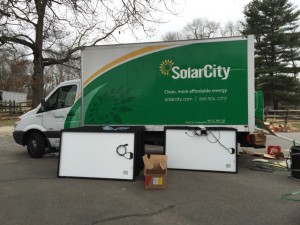 It was a bit nerve wracking waiting for the project to begin 8 months after my April sign up date. This put us smack dab in the middle of winter for a December 8th install in New England. We’ve had snow and ice storms along the way which made me more skeptical that the install would ever take place.
It was a bit nerve wracking waiting for the project to begin 8 months after my April sign up date. This put us smack dab in the middle of winter for a December 8th install in New England. We’ve had snow and ice storms along the way which made me more skeptical that the install would ever take place.
I’m happy to report that the entire SolarCity team in charge of the project arrived on the scheduled date. They were late due to leftover work at a different site, but they turned up despite the wet weather, 30 degree temperature and got right to work. It was immediately evident that this crew knew what they were doing and it was just another day on the job despite the magnitude of the install.
Solar Panel Installation
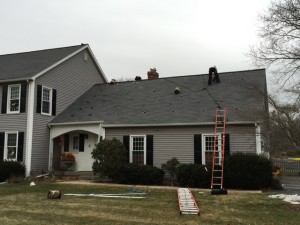 The first order of business was to tape off and secure the area from foot traffic. Anchors are attached to the roof which the crew secured their safety harnesses to.
The first order of business was to tape off and secure the area from foot traffic. Anchors are attached to the roof which the crew secured their safety harnesses to.
Once the precautionary safety measures were in place, the crew began setting up dozens of anchor points across the roof surfaces later to be used as mounting points for the solar panels. That part took most of the first day.
By the end of the first day they had managed to install solar panels on the smaller of the 2 roof lines and had most of the anchors ready on the larger roof line.
Weather Proof Guarantee
A Noreaster hit right in the middle of the week so installation was postponed. To make matter worse, all of the heavy rain and cold weather ended up icing over the roof. I crawled into both attics below each roof to ensure that all of the nails and anchors on the roof didn’t create a leak and was relieved to find that everything was totally dry.
SolarCity guarantees a leak-free installation so it was great to be able to validate that even after torrential rains.
The crew returned on the third day despite the rain and proceeded to work a full day in extremely cold weather and light rain.
Uh oh, Design Challenges
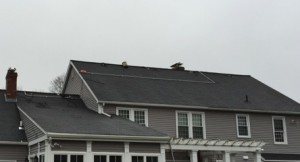 Two different design issues were uncovered during the solar panel installation. The first of which was related to a misjudgment on the number of solar panels that would fit. Designers back at corporate had mapped out 70 panels for the roof, but one of the panels would not fit behind the chimney. The crew offered to stick it somewhere else, but we declined as it would have been asymmetrical anywhere else and the aesthetics would not have been good. So we ended up with a total of 69 panels and a slight decrease in target generation capacity.
Two different design issues were uncovered during the solar panel installation. The first of which was related to a misjudgment on the number of solar panels that would fit. Designers back at corporate had mapped out 70 panels for the roof, but one of the panels would not fit behind the chimney. The crew offered to stick it somewhere else, but we declined as it would have been asymmetrical anywhere else and the aesthetics would not have been good. So we ended up with a total of 69 panels and a slight decrease in target generation capacity.
The second issue was identified on the third day. While the entire install was on the front of the house (thanks to National Grid), they had a pipe running in the middle of the roof on the rear of the house which looked stupid and unnecessary.
I spoke to them about it and they cheerfully redesigned and relocated the entire pipe. In the rain. In 30 degree weather. On top of the house. The install team took our concerns seriously and took care of the problem.
The Final Touches
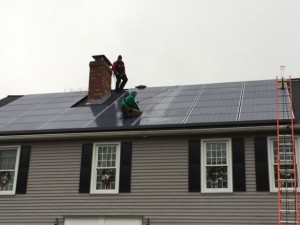 After lugging the panels up all day (each panel weighs about 45 pounds) and mounting them, they took the time to level each of them so they were completely flat.
After lugging the panels up all day (each panel weighs about 45 pounds) and mounting them, they took the time to level each of them so they were completely flat.
At one point a single panel in the middle of the lot was a bit out of place (not perfect) so one of the guys had to slide down the wet, cold, glass on his knees (getting soaked in the process), 30 feet above ground with just a line to keep him safe just to adjust the angle slightly. Those installers are hard core!
Electric Connection
 I was surprised that SolarCity needed no access to the house (other than for bathroom breaks) to do the job. The entire connection for my house was on the outside. They needed to cut the power for about 45 minutes to connect into the mains but otherwise there was very little disruption.
I was surprised that SolarCity needed no access to the house (other than for bathroom breaks) to do the job. The entire connection for my house was on the outside. They needed to cut the power for about 45 minutes to connect into the mains but otherwise there was very little disruption.
The size of the installation required 3 inverters which they placed on the side of the house.
Next Steps
The process leading up to the install (3 part series) was frustrating and error-prone between the reluctant power company and the mistakes made by the out-of-touch engineers back at SolarCity corporate. But SolarCity’s installation team was nothing but first class, all the way. They knew their stuff, were very safety conscious and worked through some harsh conditions to get the job done, and done well. They restored my confidence in the decision I made and I’m confident again that things are going to work out well.
Now that the system is installed and ready to go we need to have the inspections done. SolarCity coordinates it all, but there’s a building inspection, an electrical inspection and then an inspection by the power company. Once all passes (in about 3-4 weeks) we’re given the green light to flip the switches and start putting that free energy from the sun to good use.

News
Tesla (TSLA) receives “Buy” rating and $551 PT from Canaccord Genuity
He also maintained a “Buy” rating for TSLA stock over the company’s improving long-term outlook, which is driven by autonomy and robotics.

Canaccord Genuity analyst George Gianarikas raised his Tesla (NASDAQ:TSLA) price target from $482 to $551. He also maintained a “Buy” rating for TSLA stock over the company’s improving long-term outlook, which is driven by autonomy and robotics.
The analyst’s updated note
Gianarikas lowered his 4Q25 delivery estimates but pointed to several positive factors in the Tesla story. He noted that EV adoption in emerging markets is gaining pace, and progress in FSD and the Robotaxi rollout in 2026 represent major upside drivers. Further progress in the Optimus program next year could also add more momentum for the electric vehicle maker.
“Overall, yes, 4Q25 delivery expectations are being revised lower. However, the reset in the US EV market is laying the groundwork for a more durable and attractive long-term demand environment.
“At the same time, EV penetration in emerging markets is accelerating, reinforcing Tesla’s potential multi‑year growth runway beyond the US. Global progress in FSD and the anticipated rollout of a larger robotaxi fleet in 2026 are increasingly important components of the Tesla equity story and could provide sentiment tailwinds,” the analyst wrote.
Tesla’s busy 2026
The upcoming year would be a busy one for Tesla, considering the company’s plans and targets. The autonomous two-seat Cybercab has been confirmed to start production sometime in Q2 2026, as per Elon Musk during the 2025 Annual Shareholder Meeting.
Apart from this, Tesla is also expected to unveil the next-generation Roadster on April 1, 2026. Tesla is also expected to start high-volume production of the Tesla Semi in Nevada next year.
Apart from vehicle launches, Tesla has expressed its intentions to significantly ramp the rollout of FSD to several regions worldwide, such as Europe. Plans are also underway to launch more Robotaxi networks in several more key areas across the United States.
News
Waymo sues Santa Monica over order to halt overnight charging sessions
In its complaint, Waymo argued that its self-driving cars’ operations do not constitute a public nuisance, and compliance with the city’s order would cause the company irreparable harm.

Waymo has filed a lawsuit against the City of Santa Monica in Los Angeles County Superior Court, seeking to block an order that requires the company to cease overnight charging at two facilities.
In its complaint, Waymo argued that its self-driving cars’ operations do not constitute a public nuisance, and compliance with the city’s order would cause the company irreparable harm.
Nuisance claims
As noted in a report from the Los Angeles Times, Waymo’s two charging sites at Euclid Street and Broadway have operated for about a year, supporting the company’s growing fleet with round-the-clock activity. Unfortunately, this has also resulted in residents in the area reportedly being unable to sleep due to incessant beeping from self-driving taxis that are moving in and out of the charging stations around the clock.
Frustrated residents have protested against the Waymos by blocking the vehicles’ paths, placing cones, and “stacking” cars to create backups. This has also resulted in multiple calls to the police.
Last month, the city issued an order to Waymo and its charging partner, Voltera, to cease overnight operations at the charging locations, stating that the self-driving vehicles’ activities at night were a public nuisance. A December 15 meeting yielded no agreement on mitigations like software rerouting. Waymo proposed changes, but the city reportedly insisted that nothing would satisfy the irate residents.
“We are disappointed that the City has chosen an adversarial path over a collaborative one. The City’s position has been to insist that no actions taken or proposed by Waymo would satisfy the complaining neighbors and therefore must be deemed insufficient,” a Waymo spokesperson stated.
Waymo pushes back
In its legal complaint, Waymo stated that its “activities at the Broadway Facilities do not constitute a public nuisance.” The company also noted that it “faces imminent and irreparable harm to its operations, employees, and customers” from the city’s order. The suit also stated that the city was fully aware that the Voltera charging sites would be operating around the clock to support Waymo’s self-driving taxis.
The company highlighted over one million trips in Santa Monica since launch, with more than 50,000 rides starting or ending there in November alone. Waymo also criticized the city for adopting a contentious strategy against businesses.
“The City of Santa Monica’s recent actions are inconsistent with its stated goal of attracting investment. At a time when the City faces a serious fiscal crisis, officials are choosing to obstruct properly permitted investment rather than fostering a ‘ready for business’ environment,” Waymo stated.
News
Tesla FSD v14.2.2 is getting rave reviews from drivers
So far, early testers have reported buttery-smooth drives with confident performance, even at night or on twisty roads.

Tesla Full Self-Driving (Supervised) v14.2.2 is receiving positive reviews from owners, with several drivers praising the build’s lack of hesitation during lane changes and its smoother decision-making, among others.
The update, which started rolling out on Monday, also adds features like dynamic arrival pin adjustment. So far, early testers have reported buttery-smooth drives with confident performance, even at night or on twisty roads.
Owners highlight major improvements
Longtime Tesla owner and FSD user @BLKMDL3 shared a detailed 10-hour impression of FSD v14.2.2, noting that the system exhibited “zero lane change hesitation” and “extremely refined” lane choices. He praised Mad Max mode’s performance, stellar parking in locations including ticket dispensers, and impressive canyon runs even in dark conditions.
Fellow FSD user Dan Burkland reported an hour of FSD v14.2.2’s nighttime driving with “zero hesitations” and “buttery smooth” confidence reminiscent of Robotaxi rides in areas such as Austin, Texas. Veteran FSD user Whole Mars Catalog also demonstrated voice navigation via Grok, while Tesla owner Devin Olsen completed a nearly two-hour drive with FSD v14.2.2 in heavy traffic and rain with strong performance.
Closer to unsupervised
FSD has been receiving rave reviews, even from Tesla’s competitors. Xpeng CEO He Xiaopeng, for one, offered fresh praise for FSD v14.2 after visiting Silicon Valley. Following extended test drives of Tesla vehicles running the latest FSD software, He stated that the system has made major strides, reinforcing his view that Tesla’s approach to autonomy is indeed the proper path towards autonomy.
According to He, Tesla’s FSD has evolved from a smooth Level 2 advanced driver assistance system into what he described as a “near-Level 4” experience in terms of capabilities. While acknowledging that areas of improvement are still present, the Xpeng CEO stated that FSD’s current iteration significantly surpasses last year’s capabilities. He also reiterated his belief that Tesla’s strategy of using the same autonomous software and hardware architecture across private vehicles and robotaxis is the right long-term approach, as it would allow users to bypass intermediate autonomy stages and move closer to Level 4 functionality.








